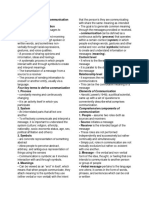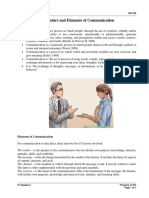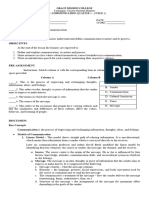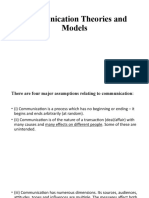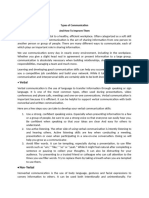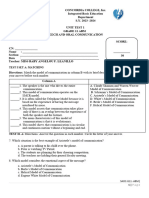Module 1 - Puposive Comm
Module 1 - Puposive Comm
Uploaded by
joshua.talosigCopyright:
Available Formats
Module 1 - Puposive Comm
Module 1 - Puposive Comm
Uploaded by
joshua.talosigOriginal Title
Copyright
Available Formats
Share this document
Did you find this document useful?
Is this content inappropriate?
Copyright:
Available Formats
Module 1 - Puposive Comm
Module 1 - Puposive Comm
Uploaded by
joshua.talosigCopyright:
Available Formats
1
COMM110- Purposive Communication
COMM110- Purposive Communication
Objectives:
At the end of this modules, you are expected to:
• explain communication process and principles;
• identify different levels of communication;
• apply principles and ethics of communication.
NATURE OF THE COMMUNICATION PROCESS
As we all know, human communication is vital for survival and it is
one thing in life that we cannot avoid to do.
Communication is:
✓ comes from the Latin word ‘communis’, which means ‘common’. To
be common means
“to
come together” or “to commune”- “to share something in
common”.
✓ is the process of exchanging ideas, thoughts, feelings and emotions
from one person to another
✓ with the use of symbols which may be verbal and/or non-verbal
and aims for understanding.
Black and Bryant (1922) define communication as:
✓ the process by which individuals share meaning.
COMM110- Purposive Communication
✓ the process by which an individual (the communicator) transmits
stimuli (usually verbal symbols) to modify the behavior of other
individuals (communicatee).
✓ occurring whenever the information is passed from one place to
another. Not simply the verbal, explicit, and intentional
transmission of message; it includes all those processes by which
people influence one another.
What then is PURPOSIVE COMMUNICATION?
Purposive communication
• is an intentional communication that happens within the
bounds of specific contexts.
• is a communication applied in specific setting,
environment, scene, social relations and culture.
Contexts affects the process of sending and receiving of messages;
semantics or meanings, choice of channels, words and methods of
delivery.
COMM110- Purposive Communication
COMMUNICATION AS A PROCESS AND ITS FOUR ATTRIBUTES
ELEMENTS OF HUMAN COMMUNICATION
Berlo’s Model of Communication (1961)
COMM110- Purposive Communication
1. Source
• refers to a person or a group of persons “with a purpose, a reason
for engaging in communication” (Berlo, 1961).
• The source initiates the communication process.
• Also referred to as the encoder, sender, information, source or
communicator.
2. Receiver
• refers to the person or group of persons at the other end of the
communication process.
• He or she is the target of the communication (Berlo, 1961).
• The receiver listens when the source talks; the receiver reads what
the source writes.
3. Message
• A source must have something to transmit.
• His or her purpose is expressed in the form of a message.
• The message may be an idea, purpose or intention that has been
translated into a code or a systematic set of symbols (Berlo, 1961).
A message has three factors:
1. Message code – any group of symbols that can be
structured in a way that is meaningful to some person. Thus,
language (sounds, letter and words) is a code because it
contains elements that are arranged in meaningful orders.
2. Message content – is the material in the message selected
by the source to express his/her purpose. Ex: research report
COMM110- Purposive Communication
(included writers’ assertion’s, information presented,
conclusions drawn.
3. Message treatment – decisions that the communication
source makes in selecting and arranging both code and
content. Ex: A journalist writes an article
(what information to include, the angle of the story, the words
he will use.)
4. Channel
• modes of encoding and decoding the messages (e.g. speaking)
• message vehicles (sound waves)
• vehicle carriers (air)
• determined by: availability, money, source preferences, which
channels are received by most people at the lower cost, which
channels have the most impact; which channels are adaptable to
the purpose of the source; which channels are most adaptable to
the content of the message.
5. Effect
• The outcome of a communication or the response of the
receiver to the message of the source.
• Sometimes it adheres to the desired outcome of the source,
sometimes the effect is not the desired outcome.
• Overt Effect – obvious or visible; responses include non-verbal
cues (nodding of head,
signing of a contract).
• Covert Effect – non-observable but sometimes they are the
most important.
COMM110- Purposive Communication
6. Feedback
• When an individual communicates with himself, the messages he
encodes are fed back into his system by his decoder (Berlo, 1960).
• A communication response is feedback to both source and receiver.
• Feedback could take form of non-verbal or verbal cues.
LEVELS OF COMMUNICATION
1. Intrapersonal Communication
✓ communication with oneself.
2. Interpersonal Communication
✓ often defined as face-to-face communication
✓ person-to-person communication – communication between
one person, a group, or a room full of people at one time but
still on a person-to person basis.
COMM110- Purposive Communication
3. Mass Communication
✓ A communication that employs technological devices (radio,
television, films) to disseminate symbolic content to large,
heterogeneous, and widely dispersed audiences (Janowitz,
1968 and McQuail, 1981).
✓ Communicating with large group of people at one time
through the use of social media.
MODELS OF COMMUNICATION
\
1. Laswell’s Model
• Harold D. Laswell, an American political scientist.
• Limitations: omits the elements of feedback; the model took for
granted that the communication is mainly a persuasive process.
No feedback
2. Shannon and Weavers “Mathematical” Model
• Claude Shannon and Warren Weaver were engineers working
for Bell Telephone Company.
COMM110- Purposive Communication
• the model answered the question
•one-way linear model
•introduced the element of noise – in technical aspect, noise is
anything that disrupts the transmission of a signal; in human
communication context, noise is anything that disrupts the
smooth flow of communication.
3. Newcomb’s Model
• Introduces the role of communication
in a society or social relationship.
• Communication maintains equilibrium
within a social system
• If A and B have similar attitudes about
X, then the system is in equilibrium.
Should their attitudes differ, then there is no equilibrium and A and
B must communicate to find a way to put their system in balance.
4. Osgood and Schramm’s
Model
• Wilbur Schramm and
Charles Osgood
• Compares their model to
Shannon and Weaver’s
COMM110- Purposive Communication
(focus on channel)
• Schramm and Osgood model focuses on the actors in the
communication to be equal in performing the tasks of
encoding, interpreting, and decoding messages.
5. Dance’s Helical Model
• Portrays the communication process as
moving.
• Shows the dynamism of the
communication process • May be used
to illustrate information gaps and the
thesis that knowledge tends to create
• more knowledge.
FORMS OF COMMUNICATION
Verbal communication
• is the transmission of ideas, opinions, feeling emotion or
attitude through the use of oral language.
• Examples of verbal communication are meetings, letters,
reports, emails, notes, memos, group discussions,
interviews, counseling, face-to-face conversations,
telephone calls, radio, etc.
COMM110- Purposive Communication
Non-verbal communication
• Refers to the sending of messages to another person utilizing
method or means other than spoken language. These methods
include the following:
a. Visual
1. Posture is the position and movement of the body. The way
we stand or carry ourselves speaks so much of our
personality
2. Gestures and Body Movements. When a student raise his
hand in a lecture class, he may want to recite, ask a
question or make a request.
3. Facial expression. It is the arrangement of facial muscles to
communicate emotional states or reactions to messages.
4. Eye Movements. It is said that “the eyes are the windows of
the soul.” Our eyes can communicate love, hatred, anger,
joy, fear or any other type of emotion. Eye movement can
be a form of feedback and therefore play an important role
in the communication process.
5. Proxemics. According to Edward T. Hall, proxemics stands
for the way people communicate by their use of space in
relation to other people.
6. Geographic Location. The position of the interactants
during a communication event shows the kind of
relationship existing between the speaker and listener.
COMM110- Purposive Communication
7. Time. A person’s observation of time reveals a lot his
personality. Punctuality and tardiness talk louder than
physical characteristics.
8. Artifacts. These refers to things or objects we put on our
body, in our homes or in our personal possessions. The
clothes we wear, the jewelry we put on, the material
objects we stores in our bags, the decorations we buy for
our hoes and places of work speak so much of ourselves.
9. Physical characteristics. The color of one’s skin, the size and
shape of one’s body or the color of one’s hair conveys a
message.
b. Auditory
1. Silence. There is a saying that “silence speaks louder than
words.” A person’s silence may mean approval or
disapproval, acceptance or non-acceptance, understanding
or lack of it.
2. Paralanguage. This is the technical name given to the non-
verbal features in speech such as intonation, pitch, louden,
and intensity.
3. Tactile. This refers to communication through touch, a
method of conveying feelings without the use of words.
4. Olfactory. This form of communication refers to smell. The
cologne or perfume we wear can tell the kind of person we
are to whoever e come in contact with in different
situations.
COMM110- Purposive Communication
COMM110- Purposive Communication
5. Gustatory. This refers to communication though taste. The
choices we make in terms of the food and drink we take for
our everyday nourishment indicate the type of individual
we are or want to become.
COMM110- Purposive Communication
COMM110- Purposive Communication
COMM110- Purposive Communication
COMM110- Purposive Communication
COMM110- Purposive Communication
p
COMM110- Purposive Communication
7C’S OF COMMUNICATION
1. Clear
There are several stages to clarity.
Firstly, it’s important to be clear about the purpose of the message you’re
delivering. The recipient should be made aware of why they are receiving
the message and what you’re trying to achieve by delivering it. If there are
multiple goals, each should be laid out separately.
Secondly, it’s essential that the content of the communication is itself
clear. You should avoid jargon, use simple language, use simple structures
and focus on the core points of your message.
COMM110- Purposive Communication
2. Correct
It’s essential that both the factual information and the language and
grammar you use are correct. If your audience spots errors in either, they
will be distracted and your credibility will be greatly reduced. This will
reduce the effectiveness of your communication.
Some communications simply must be correct, clear and concise.
3. Complete
Completeness is often one of the most important of the 7 Cs of
communication.
When creating a message, it’s important to give the recipient all of the
information they need to follow your line of reasoning and to reach the
same conclusions you have. This level of detail will be different in different
situations, and you should adjust your communications accordingly.
In addition, you should make things as easy as possible for the recipient.
For example, if you are issuing a “call to action”, provide explicit guidance
on that action. Increasingly it’s common to include things like hyperlinks in
written communications or to attach FAQs, both of which help audiences
access a complete set of information while also ensuring that core
communications focus on core messages.
4. Concrete
When shaping your communication you must ensure that you are specific
and that the logic and messages that you’re using fit together, build on
each other and support each other. Your arguments should be based on
solid facts and opinions from credible sources and you should share
irrefutable data to support your argument.
COMM110- Purposive Communication
It may be important to help bring the solid nature of what you’ve created
to life for your audience through examples that show the relevance of
your messages for them as individuals.
5. Concise
When communicating messages of this nature it’s important to stick to the
point and keep your messages short and simple. Don’t use 10 words if you
can use five. Don’t repeat your messages.
The more you say, the more risk there is of confusion. Avoid that risk by
focusing solely on the key points you need to deliver.
6. Courteous
People are not always courteous.
You can increase the effectiveness of your communications by being polite
and showing your audience that you respect them. Your messages should
be friendly, professional, considerate, respectful, open and honest.
To help ensure you are courteous, you should always use some empathy
and consider your messages from the point of view of the audience.
7. Coherent
The last of the 7 Cs of communication is coherence. If your
communications are not coherent they will not be effective. To help make
sure your communications are coherent you should have a logical flow and
your style, tone and language should be consistent throughout.
In addition to making sure that each communication you issue is coherent
within itself, you should also ensure consistency of message when
delivering multiple communications.
COMM110- Purposive Communication
ETHICS OF COMMUNICATION
Ethics
• A system of moral principles
• Deals with the value relating to human conduct, with respect to the
rightness and wrongness of actions and to the goodness and
badness of motives and ends of such action.
Communication Ethics
• The principle governing the communication, the right and wrong
aspects of it, the moral-immoral dimensions relevant to
Interpersonal Communication are called the ethics of Interpersonal
communication.
• Maintaining the correct balance between speaking and listening.
• Degree of critism and praise
Fundamentals of Ethical Communication
• Responsible thinking
• Decision making
• Development of communication and communities
Principles of Ethical Communication
1. Advocate truthfulness, accuracy, honesty, and reason as essential
to the integrity of communication.
2. Endorse freedom of expression, diversity of perspective, and
tolerance of dissent to achieve the informed and responsible
decision making fundamental to a civil society.
COMM110- Purposive Communication
3. Strive to understand and respect other communicators before
evaluating and responding to their messages.
4. Promote access to communication resources and opportunities as
necessary to fulfill human potential and contribute to the well-
being of families, communities, and society.
5. Promote communication climates of caring and mutual
understanding that respect the unique needs and characteristics of
individual communicators.
6. Condemn communication that degrades individuals and humanity
through distortion, intimidation, coercion, and violence, and
through the expression of intolerance and hatred.
7. Committed to the courageous expression of personal convictions in
pursuit of fairness and justice.
8. Advocate sharing information, opinions, and feelings when facing
significant choices while also respecting privacy and confidentiality.
9. Accept responsibility for the short- and long-term consequences of
our own communication and expect the same of others.
MODULE 1 INSIGHT
Congratulations for finishing Module 1! Let’s assess your learnings
base on the objectives of this module. Write your take-aways from
this module (maximum of 1 paragraph). (Grading rubric:
50% Reflective, 25% Coherence, 25% Conciseness)
COMM110- Purposive Communication
ACTIVITY/WORKSHEET 1: ESSAY
Direction: (Grading rubric: 50% Reflective, 25% Coherence, 25%
Conciseness)
COMM110- Purposive Communication
1. Write an essay on “how the pandemic changes our way of
communication.”
2. Minimum of 2 paragraphs and maximum of 5 paragraphs.
3. You can write it in this module or in google classroom.
COMM110- Purposive Communication
You might also like
- Module 1 - Puposive CommDocument19 pagesModule 1 - Puposive CommIRENE SEBASTIANNo ratings yet
- Module 1 - Lesson 1Document15 pagesModule 1 - Lesson 1justine joshua pinedaNo ratings yet
- Purcomm Reviewer PrelimDocument7 pagesPurcomm Reviewer PrelimzashileighNo ratings yet
- PURCOMDocument8 pagesPURCOMAlyson Kate CastillonNo ratings yet
- Purposive CommunicationDocument13 pagesPurposive CommunicationKate Rose SantosNo ratings yet
- Lesson 1 Communication (Process and Types)Document32 pagesLesson 1 Communication (Process and Types)Nathaniel CataquisNo ratings yet
- (Unit 1) Lesson 1 - Communication Process, Principles, and EthicsDocument48 pages(Unit 1) Lesson 1 - Communication Process, Principles, and EthicsJOHN LOREN JACOLONo ratings yet
- GE 5 NotesDocument43 pagesGE 5 NotesKenneth Alviar RocaporNo ratings yet
- CommunicationDocument114 pagesCommunicationKundan JhaNo ratings yet
- Basic Purposive CommunicationDocument38 pagesBasic Purposive CommunicationDimple EstacioNo ratings yet
- What Is A Communication ModelDocument39 pagesWhat Is A Communication ModelDanica CabelloNo ratings yet
- Types of Speech ContextDocument7 pagesTypes of Speech ContextRomy Sales Grande Jr.No ratings yet
- Models of CommunicationDocument20 pagesModels of CommunicationNiro MadlusNo ratings yet
- 1st Quarter Key Concepts Oral CommunicationDocument20 pages1st Quarter Key Concepts Oral CommunicationbpaulmarcusNo ratings yet
- Advanced Communication and Counselling Skill - Unit 1Document77 pagesAdvanced Communication and Counselling Skill - Unit 1tayebwanobert97No ratings yet
- Oral Com Week 1aDocument21 pagesOral Com Week 1aAlkin RaymundoNo ratings yet
- The Nature and Elements of CommunicationDocument7 pagesThe Nature and Elements of CommunicationHazel Prado CerdaNo ratings yet
- Purcom Unit 1 ReviwerDocument3 pagesPurcom Unit 1 ReviwerRoan Eam TanNo ratings yet
- 1 Nature and Elements of CommunicationDocument52 pages1 Nature and Elements of CommunicationPrincess Joy Gavileño100% (2)
- Business CommunicationDocument74 pagesBusiness CommunicationHardik SNo ratings yet
- Communication Processes, Principles, and Ethics (Reviewer)Document4 pagesCommunication Processes, Principles, and Ethics (Reviewer)Jessie Tindoy100% (1)
- Oral Com 11Document52 pagesOral Com 11Nicka NipalesNo ratings yet
- Business Communication Unit-1 And2Document74 pagesBusiness Communication Unit-1 And2Kohli ViratNo ratings yet
- PC Review ClassDocument83 pagesPC Review Classkat rinaNo ratings yet
- Lesson 1 Media and CommunicationDocument33 pagesLesson 1 Media and Communicationkean94607No ratings yet
- Communication 2Document76 pagesCommunication 2AngelNo ratings yet
- Module No. 2Document5 pagesModule No. 2Zarah CaloNo ratings yet
- Communication: The Basics: Dr. Jeson A. Bustamante Department of Languages and Literature College of Arts and SciencesDocument25 pagesCommunication: The Basics: Dr. Jeson A. Bustamante Department of Languages and Literature College of Arts and SciencesSEAN ANDREX MARTINEZNo ratings yet
- NGEC5 Midterm HandoutsDocument7 pagesNGEC5 Midterm Handouts나쁜No ratings yet
- 1a PPT Communication Processes Principles Elements and FunctionsDocument54 pages1a PPT Communication Processes Principles Elements and FunctionsLheirene Mae GozonNo ratings yet
- PURPOSIVE-COMMUNICATION-REVIEWERDocument10 pagesPURPOSIVE-COMMUNICATION-REVIEWERcharlesmark.espedillaNo ratings yet
- Purposive CommunicationDocument18 pagesPurposive Communicationcoco.codm00No ratings yet
- Reviewer Sa Purcom KC Mahal Q KauDocument8 pagesReviewer Sa Purcom KC Mahal Q Kaun67wn7pr9mNo ratings yet
- Oral Communication - Grade 11Document5 pagesOral Communication - Grade 11JullianaNo ratings yet
- PURPOSIVE REVIEWER For CollegeDocument8 pagesPURPOSIVE REVIEWER For CollegeJoemar IgnacioNo ratings yet
- Oral Com First Sem NotesDocument19 pagesOral Com First Sem NotesnikkidemonyoNo ratings yet
- Participate in Workplace Communications SUMMARYDocument1 pageParticipate in Workplace Communications SUMMARYRicky RaymundoNo ratings yet
- Oral Communication NotesDocument10 pagesOral Communication NotesMR. LNo ratings yet
- Week 1 2Document14 pagesWeek 1 2jaylordlungayanNo ratings yet
- Oral Com ReviewerDocument5 pagesOral Com ReviewerEricka Magadia100% (1)
- GE 105 Lesson 1Document55 pagesGE 105 Lesson 1walter netNo ratings yet
- Sta ReviewerDocument7 pagesSta ReviewerClara Rafaela Waje TuazonNo ratings yet
- Oral Communication ReviewerDocument8 pagesOral Communication ReviewerLeonard Salvacion100% (1)
- COR1 Oral Communication in ContextDocument63 pagesCOR1 Oral Communication in ContextJohn Kennedy QuinesNo ratings yet
- 1 Purposive Com Handout 2024Document20 pages1 Purposive Com Handout 2024Jessa Mae SusonNo ratings yet
- Edited Revised Lesson 1 - (Purposive Communication)Document43 pagesEdited Revised Lesson 1 - (Purposive Communication)JELICEL ATENo ratings yet
- 8 Models of CommunicationDocument9 pages8 Models of CommunicationLornaNo ratings yet
- IntroductionDocument22 pagesIntroductionGlemil Jan Gimoto AlbaniaNo ratings yet
- Nonverbal Communication: Communication Is The Activity of Conveying MeaningfulDocument9 pagesNonverbal Communication: Communication Is The Activity of Conveying MeaningfulSanndy KaurNo ratings yet
- Cas 101 NotesDocument5 pagesCas 101 NotesSeungyoun parkNo ratings yet
- Models of CommunicationDocument2 pagesModels of CommunicationZarah CaloNo ratings yet
- Oral Communication ReviewerDocument6 pagesOral Communication Reviewerariannaclarisse05No ratings yet
- Gen 1Document106 pagesGen 1PRINCE ANGELO BARCELONANo ratings yet
- Teacher: Dr. Ayesha Riaz Mam Humera Hina Mr. Faisal Ihsan EDU-504 - 3 (3-0)Document16 pagesTeacher: Dr. Ayesha Riaz Mam Humera Hina Mr. Faisal Ihsan EDU-504 - 3 (3-0)Nabeel TahirNo ratings yet
- Advanced CommunicationDocument8 pagesAdvanced Communicationryankylle20No ratings yet
- Shannon-Weaver's Communication Model (1948)Document7 pagesShannon-Weaver's Communication Model (1948)Joyce Ann JimenezNo ratings yet
- Quarter 1 Week 1 - Oral ComDocument3 pagesQuarter 1 Week 1 - Oral ComKim JayNo ratings yet
- Communication Theories & ModelsDocument28 pagesCommunication Theories & ModelsSaeedomarNo ratings yet
- Reflections in Communication: An Interdisciplinary ApproachFrom EverandReflections in Communication: An Interdisciplinary ApproachNo ratings yet
- The Nonverbal Factor: Exploring the Other Side of CommunicationFrom EverandThe Nonverbal Factor: Exploring the Other Side of CommunicationNo ratings yet
- Communicat. Model AssignmentDocument6 pagesCommunicat. Model AssignmentHailu TamirNo ratings yet
- Berlo's SMCR Model of CommunicationDocument19 pagesBerlo's SMCR Model of Communicationareebadilshad2No ratings yet
- Purcom Chapter 1Document44 pagesPurcom Chapter 1bonbon.kentbriannNo ratings yet
- SMCR ModelDocument20 pagesSMCR Modele.eriannaheroyNo ratings yet
- Linear Models of CommunicationDocument9 pagesLinear Models of CommunicationQueen SumawayNo ratings yet
- Odel of Communication and Barrier Communication GROUP 1Document20 pagesOdel of Communication and Barrier Communication GROUP 1anthony.042126No ratings yet
- Berlo's of CommunicationDocument8 pagesBerlo's of CommunicationJanze MoubisNo ratings yet
- Grade 11 Abm Unit Test 1.1Document3 pagesGrade 11 Abm Unit Test 1.1Angelou LeanilloNo ratings yet
- (Amaleaks - Blogspot.com) Ucsp Week 1-10Document336 pages(Amaleaks - Blogspot.com) Ucsp Week 1-10Leor Juno VicenteNo ratings yet
- Mcm431 Development Communication Solved Mcqs - Mcm431 Final Term Papers Solved Mcqs - Mcm431 Mid Term Papers Solved McqsDocument29 pagesMcm431 Development Communication Solved Mcqs - Mcm431 Final Term Papers Solved Mcqs - Mcm431 Mid Term Papers Solved McqsMuhammad AnasNo ratings yet
- Media and Information LiteracyDocument25 pagesMedia and Information LiteracyGlory Mae BastarecheNo ratings yet
- CBRC - Business and Purposive CommunicationDocument3 pagesCBRC - Business and Purposive CommunicationJay Respuesto Alvia QuilisadioNo ratings yet
- Communication Gerbner'S Model of CommunicationDocument2 pagesCommunication Gerbner'S Model of CommunicationFrances Clair SanchezNo ratings yet
- TVL-G12-Local Guiding-Q2 - Wk-1-4-QADocument29 pagesTVL-G12-Local Guiding-Q2 - Wk-1-4-QAMariah ArcalaNo ratings yet
- Oral Communication ReviewerDocument10 pagesOral Communication ReviewerjoshadrianvavaldezNo ratings yet
- Chapter FourDocument72 pagesChapter FourBerheNo ratings yet
- 1st Quarter Key Concepts Oral CommunicationDocument20 pages1st Quarter Key Concepts Oral CommunicationbpaulmarcusNo ratings yet
- Midterm Speech and Theatre Arts ModuleDocument42 pagesMidterm Speech and Theatre Arts ModuleEthyl Grace HaroNo ratings yet
- Topic 3 - Communication ModelsDocument14 pagesTopic 3 - Communication Modelsmorenikejiolabisi218No ratings yet
- Module 3 Communication Process Principles and Ethics - Purposive Communication 1Document6 pagesModule 3 Communication Process Principles and Ethics - Purposive Communication 1Brazil John A ValdezNo ratings yet
- Indian Mass Communication: MessageDocument15 pagesIndian Mass Communication: Messagesagarkanojiamjmc_449No ratings yet
- COMMUNICATION-MODELS BarbsgenDocument14 pagesCOMMUNICATION-MODELS BarbsgenYanie Kyle MungcalNo ratings yet
- Reviewer For Advance CommDocument8 pagesReviewer For Advance Commdphoenix0802No ratings yet
- Communicating in The 21st Century 4e - (Chapter 1 Communication Today)Document21 pagesCommunicating in The 21st Century 4e - (Chapter 1 Communication Today)syedimranmasood100No ratings yet
- Purposive Communication Course OutlineDocument9 pagesPurposive Communication Course OutlineBoang KaNo ratings yet
- Reviewer in Oral ComDocument2 pagesReviewer in Oral ComMarjorie PabloNo ratings yet
- PCMQ1 QuestionnaireDocument5 pagesPCMQ1 Questionnaireshie78810No ratings yet
- 2023 AE Final Coaching Upstep Review Center QuestionnaireDocument21 pages2023 AE Final Coaching Upstep Review Center QuestionnaireMarianne MendozaNo ratings yet
- Communication Skills - 20UCT141Document53 pagesCommunication Skills - 20UCT141kisok73805No ratings yet
- TPS 4thQ Module3Document17 pagesTPS 4thQ Module3alonzomarynelleNo ratings yet


